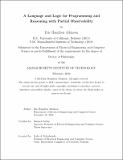| dc.description.abstract | Computer systems are increasingly deployed in partially-observable environments, in which the system cannot directly determine the environment’s state but receives partial information from observations. When such a computer system executes, it risks forming an incorrect belief about the true state of the environment. For example, the Mars Polar Lander (MPL) is a lost space probe that crashed because its control software believed it was on the Martian surface when it was actually 40m high, and as a result, it turned off its descent engine too early. Developers need better software development tools to prevent such accidents.
In this dissertation, I will present programming language tools that enable developers to deliver correct software in partially-observable environments. In particular, I will present belief programming, a new type of programming language in which developers write a model of the partial observability in the environment. The language produces an executable state estimator, which is a function that maps environmental observations to estimates of the environment’s true state. I have implemented the prototype belief programming language BLIMP, and used BLIMP to implement several example programs – including an engine controller for the MPL. I will also present Epistemic Hoare Logic (EHL), a program logic for belief programs that enables developers to reason about properties of the resulting state estimators. I have used EHL to prove that the BLIMP version of the MPL does not have the error that caused the original MPL to crash. Furthermore, I will present semi-symbolic inference, a technique that provides more efficient implementations of belief programming languages. Across a range of benchmarks, my performance experiments show that a semi-symbolic BLIMP implementation achieves speedups of 515x-58,919x over a naïve BLIMP implementation. Together, the contributions of belief programming, EHL, and semi-symbolic inference enable developers to focus on modeling the partial observability in the environment, and provide programming language support for automatically generating and reasoning about efficient state estimators. | |
